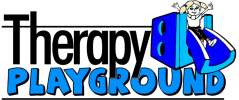https://youtu.be/GQnOhpD2vhI
Megan and Jenny discuss some of the differences between physical and occupational therapy.
Welcome back to Therapy Playground, I’m Megan Myrick, I’m a physical therapist. And I’m Jenny Holland, I’m an occupational therapist. And this is Micah.
Micah receives speech therapy, occupational therapy, and physical therapy at Therapy Playground.
Like most kids, he spends a lot of time here, and we’re working really hard to help Micah meet his potential. Our main goal as providers here is to ensure children are maximizing their ability for independence and maximizing their participation in their function.
We meet these goals in different ways. And a lot of times parents ask “What exactly is the difference between physical and occupational therapy?”.
And we’re here to discuss that today. So Jenny why don’t you start by talking about some of the things that you work with Micah, what your goals are, and what might be different from what he and I do.
Well usually when I’m asked this question I start by telling people that occupational therapy is we look at your ability to be independent in doing things for yourself.
So for a child that typically means playing, or being able to function in a classroom, to be able to do your school work, to be able to do your activities of daily living, which include bathing, dressing, self-hygiene, toileting, grooming. All those things are included in all our daily lives, but for the child in particular, a lot of their lives involve around play and school.
So for a child like Micah, he has difficulty using his left hand, so we’re doing a lot of grasping and reaching with his left arm, because we use our hands to be independent, and Micah wants to play, so we need that left hand to play, so we do a lot of sitting, reaching, and grasping.
In Physical Therapy my goals are a little bit different, although I want Micah to do all those things. My role is to help him be able to access those things. For example, Micah’s having difficulty assuming quadraplanic crawling, getting on all fours, so we work on crawling, we work on his mobility skills. Eventually we will work on walking. We work on the overall strength in his trunk and his legs so that he can sit up and perform the skills that Jenny talked about.
So in a nutshell, I would think that probably physically therapy is more focused on generalized strengthening and mobility skills, whereas occupational therapy is more focused on specific activities of daily living like Jenny mentioned. But also, Jenny just finished a course on sensory integration, so she’s able to apply that to her therapy sessions with children.
Sensory Integration is also part of OT, which is the ability to receive information from all our senses, such as eyes, ears, nose, sense of smell, sense of movement which is your vestibular system. All of these senses we take in every day, and we take input from these senses and we have to be able to integrate them to function.
If a child’s or persons sensory system is not processing these properly they may have difficulty tolerating things such as textures, may have difficulty eating or feeding, difficulty exploring their environment because of these sensitivities.
They may also very hyper or sensory seeking, so that would be a child or person who is very active unable to attend to task because they were very, very busy trying to seek out the information their body needs.
That’s great. If you have any questions about what we have to offer at Therapy Playground or physical therapy or occupational therapy, please feel free to contact us or visit our website at www.therapyplayground.com.
